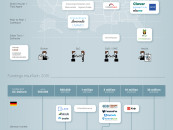The market for cloud services is expected to skyrocket in the next few years, and according to industry experts, there are many reasons to believe that insurers will be in the forefront of this growth.
But first: what is cloud computing?
Simply put, cloud computing is the delivery of computing services such as servers, storage, databases, networking, software and analytics, over the Internet, or the “cloud.” It is a big shift from the traditional way businesses think about IT resources and among the key advantages of opting for cloud computing services include cost, speed, the ability to scale elastically, productivity, performance, and reliability.
But perhaps the real promise of cloud computing lies in developing new markets and services. Cloud computing provides the capabilities businesses need on a flexible basis to respond quickly and cost-effectively to changing conditions. By combining virtualization and multi-tenant architectures with a pay-as-you go business model, cloud computing proposes a new model that impacts the way IT infrastructure, platform, application and business processes capabilities are procured, delivered and supported.
Cloud computing in the insurance business

Health, Pixabay
Cloud computing has transformed many industries with its ease of deployment, resourcefulness and flexibility, and the insurance industry is set to be no exception.
In particular, insurers are experimenting with cloud to drive revenue, improve collaboration, and gain customer insight. Among the key opportunities of cloud computing in the insurance business, Accenture cites:
- Reduced costs of IT ownership and operation
- Unified customer data, enabling customer-centricity
- More effective customer engagement through new distribution models
- Peaks in demand handled more easily and at lower cost
- Reduced speed to market and new business opportunities
- Shift to a service-oriented model and new innovation in systems design
- Better management of intermediary relationships
- Maximized renewals by customers
- Possible integration of third party systems/agency management systems
Vincent Cohan, senior vice president and chief technology officer, and Sauro Nicli, global information officer, of AXA, have said in 2010:
“Cloud computing could materially change how we develop applications and apply technology to business, especially when it comes to cost structure, investment and agility.”
Cloud computing is also critical for the Internet-of-Things (IoT), a thriving industry. Having connected devices such as wearables provide insurers with a wealth of information to determine anything from driver behavior to the need for pre-emptive medical care. This is done by generating a significant amount of data, which need to be stored, managed and analyzed correctly and in real-time.
The cloud overcomes many of these challenges. Instead of having to rely on the capabilities of an on premise server room, insurers can utilize the cloud for both storage and real-time analytical modelling, without having internal processing or storage constraints. Data can be easily shared amongst stakeholders and decisions can be validated more quickly due to this ‘fingertip’ access to the analytics.
As the momentum of cloud computing continues, issues surrounding data protection, privacy, and regulation have arisen.
Swiss Fintech Innovations (SFTI), an independent association of banks and insurance firms launched in March 2016 to foster innovation in the Swiss financial industry, recently released its position paper on Cloud Rules and Regulations from the Perspective of Insurance Companies which it presented earlier this month to the Swiss Bankers Association and the Swiss Insurance Association.
Insurance members of SFTI formed the Cloud Rules and Regulations working group one and a half year ago to make the use of cloud servers for insurance companies legally feasible. The position paper is intended to initiate the regulations necessary for implementation of cloud technology in the insurance business. It also records what has already been learned in the process of going into the cloud with the data and what needs to be taken into account. One of the key pillars here is the need of complying with data security.
Patrick Baumberger, President of SFTI told Fintechnews:
“Cloud Computing is one of the most important digital priorities for financial institutions in Switzerland, hence SFTI aims to address future data-driven business models. We welcome all banks and insurance companies to be part of it and join us in our working groups.”
Featured image credit: Pixabay






